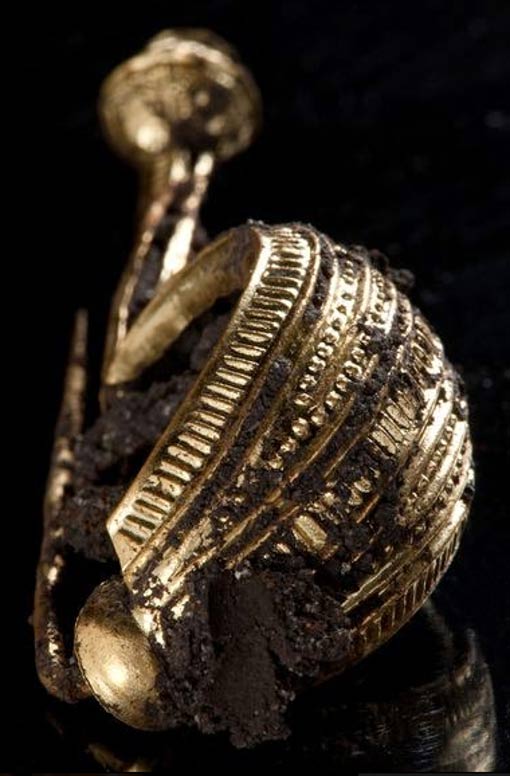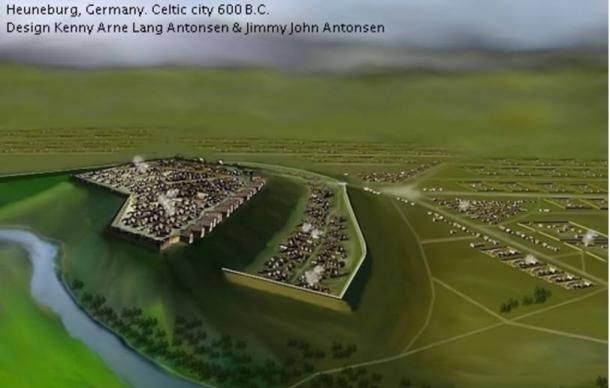
Examining the Rich Tomb of a Mysterious Celtic Princess
Celtic princesses are almost mythical in today’s modern culture. They are often considered as women with mystical talents and hidden stories. A grave discovered beside the Danube River brings much information about a woman who was perhaps a real Celtic princess.
A large burial which contained the skeleton of a Celtic noblewoman was discovered in 2009 beside the Danube River near Heuneburg, in the south of Germany. It is the oldest known wealthy grave of a Celtic woman. The grave was quite well preserved by the water-sodden soil of the region. The burial chamber of the tomb was wooden, the oak of the floor was intact, and it was possible to put an exact date on it. The oak trees used in the tomb were felled 2,620 years ago. With this discovery, one can determine that the woman buried in the tomb died in 609 BC.

Course of the Danube, marked in red. (Public Domain)
The Treasure of the Celtic Princess
The tomb was never looted, so all the treasures which ancient people gave to the noble lady were still there when it was opened. The tomb was lifted by heavy cranes in December 2010 and transported to a tented laboratory near Stuttgart, Germany. It weighs 80 tons, so the process was challenging. The research by archaeologists associated with the Stuttgart Regional Council provided better results than they had expected. The tomb was full of amber jewelry, gold, bronze, and more.

Artifact from the grave of the Celtic princess near Heuneburg. (benedante.blogspot)
The burial of the woman contained one more surprise – an unidentified child. It is difficult to say anything about the baby, but perhaps it was a child related to the woman, quite possibly she was its mother. It has been suggested that they died together, so it is likely that their death was caused by an accident, attack, or disease. Apart from the treasure and child, pieces of cloth, food, and other organic matter were found.
- 2,500-year-old Celtic tomb with richly adorned body may belong to a Prince or Princess
- The Strange Story of Daisy of Pless and Her Long Sought After Necklace
- Moments from the Life and Reign of Queen Victoria of Great Britain

Piece of jewelry found at the site. (benedante.blogspot)
Who Was the Woman in the Tomb?
Interpreting the discovery is very difficult because there are no written sources, diaries, or chronicles about this period in the history of the Celts near the Danube River. The archaeologists examined every centimeter of the tomb with brushes, tweezers, and scrapers. Along with the aforementioned human remains and the treasures, animal and plant remains were also found. The analysis of these can provide information about burial rituals. It is known that the Celts used the plants which were grown nearby, so in some parts of Europe, the rituals looked a little bit different.
It is known that the woman died between the ages of 30 and 40. She was an elite person and her tomb was a cache of ornate treasures. The tomb is one of the greatest discoveries connected with a female Celtic burial. The gold necklaces set with pearls and the amber jewelry have also provided a better understanding about the art of the Celts from the period of the 7 th century BC.
It must be noted that although researchers call her “the princess,” in fact there is nothing really known about her life and role in society. The only sure thing is that she was a very important individual. As long as there is no concrete answer to the question of who the woman and child were, they have been called the princess and prince of the Celts.
Lasers and scanners used during research allowed archaeologists to create a 3D computer simulation which presents the way the burial chamber looked on the day of the funeral. The tomb was found very close to the excavation site in Heuneburg, which for centuries was believed to be a Celtic settlement. The discovered grave confirmed that the area of Heuneburg was one of the earliest centers of Celtic art and culture.

Reconstructed Celtic Heuneburg in 600 BC. (CC BY-SA 4.0)
A Luxurious Life for the Celts
People often believe that the heartland of the Celts is Western Europe – Wales, Scotland, Ireland, Brittany in France, etc. However, discoveries such as the one made near the Danube River suggest that Central Europe was very important for the Celts too. Some researchers believe that Celtic art and culture could even have had its origins in south-western Germany, eastern France, and Switzerland - not in the North.
Roman writers described the Celts as barbaric, only excelling in violence and war. However, this picture was created to explain how the Celts managed to conquer Rome in the year 387 BC. Romans tried to explain that these people were focused on war and knew nothing else, had no philosophy, humanist values, etc.
- Exploring the Little Known History of Celtic Warriors in Egypt
- Thoth’s Storm: New Evidence for Ancient Egyptians in Ireland?
- Bloody Mary: The Marriage, Reign, and Death of a Queen of England
At the same time, the center of Celtic culture in Germany contained a city of as many as 10,000 people. And the society was living in luxury. According to archaeological excavations, they were drinking Greek wine, ate food from Iberia, and wore Etruscan gold jewelry. During those times Rome was the one which could have been considered a poor place in comparison.
The results of research show that the princess from the tomb and her people were much more interested in culture and comfort than in war. People who lived near the Danube River were advanced and likely saw war as a tool to earn more treasure, which allowed them to live a better life.
Archaeologists and historians hope that the discovery of the Celtic princess will help in the future in research about the Celtic wars of domination, which remain one of the greatest secrets in the history of Europe. Specialists still cannot find the answer to why the Celts created a powerful empire, only to disappear from history in the first centuries AD.

Celtic Princess Site. (benedante.blogspot)
The Importance of Celtic Women
Celtic women were distinct in the ancient world due to the liberty and the rights they enjoyed. The position of a woman in Celtic society was higher than one of the same period living in Greece or the Roman Empire. Ancient Celtic women were allowed much more freedom and they were protected under the law.
The society of the Iron Age was a patriarchic one, but that was primarily caused by the war expeditions, during which men brought new goods into the Celtic society. Nevertheless, women were warriors, mothers, wives, and much more.
Featured image: "Isolde" (1911) by Gaston Bussiere. Isolde, an Irish princess, and her lover Tristan are the principal characters of a famous medieval romance story that was based on a Celtic legend. Source: CC BY NC 2.0
References:
James, S., The world of the Celt, 1993.
Markale, J., Women of the Celts. 1986.
Wilde, L. W., Celtic women in legend, myth and history, 1997.
http://news.nationalgeographic.com/news/2011/06/pictures/110621-celtic-princess-tomb-gold-amber/















Comments
I just saw my recent Comment, went thru some others posted recently. I'll use this Comment as a test for possibly some TECH problem; The word 'amp' keeps coming up & I don't know why ! Not sure. If I'm typing in an 'AND', or 'and', that'd be okay. I use the symbol '&' often. I haven't seen this happening on other venues where Comments are written or received, and, so, I'm at a loss. Excuse the problem folks, if you would, trying to nail it down. I do wonder if anyone 'out there' sees the 'amp' word come up in my Comments, or is my stuputer rebelling?! Thanks for the space, & hopefully understanding. Mike
Hi Carol, If you're referring to my Comment, that's neat! ( or cool, far out-whatever's handy! ).This is like another event! Some years ago, some guy doing research in Wales, where mining had been the local villagers' work-'forever', at least as written records & the lore went. A skeleton was found in an old mine. He got a DNA swab from everyone in the village, & it turned out that of the 300 or so folks, one man's ( the local schoolteacher) DNA matched! So, in all that time, his family had never moved from the village! I often wonder how he felt, coming from 'homebody's', as it were! Maybe you watched the doc. about the 'Caucasian DNA testing & search for modern related folks in Mongolia, & they found it in a young girl who had the red hair & DNA as the body that'd been unearthed? Amazing stuff, good reading, sets the mind to work, doesn't it? Thanks for Commenting! Take care- Mike
wow. weird. She looks almost exactly like me.
The story brought to mind the recent discovery of the burial found on Ireland's west coast, of a young Celt woman, buried in a slab (sided, & topped) 'coffin'. The story went that she had been dated to near 6300 BC. The story was unique in the grave's construction, & that, owing to the well sealed coffin, DNA was in good condition for testing. The writer said that the new evidence proved the Celt's origin to be in the central steppes area( Going by memory here, the article was about 6 mo's ago ?). The woman's DNA matched that area, at least, supposedly, giving rise to their hopes the origin debate was over., This story 'could' show a gradual spreading westward from the original homeland, to the West-& Ireland, no doubt adding to the lore of the Celtic peoples. I will try to find the article & re-post here. It was one of those innocuous sidebar stories that always seem to be in the way of one's subject matter! I will ck back. In the meantime, has anyone else run across the article, &/or have a source available? Thanks, I'm enjoying the many subjects & people, Mike
Lovely article - one of the best things I've recently read, and by far the most useful. Cool to read such a well-considered article! So here is my saving grace: PDFfiller helped me to fill out the a form and and esign them. Just try it http://pdf.ac/2DdaOs, you'll love it.
Pages